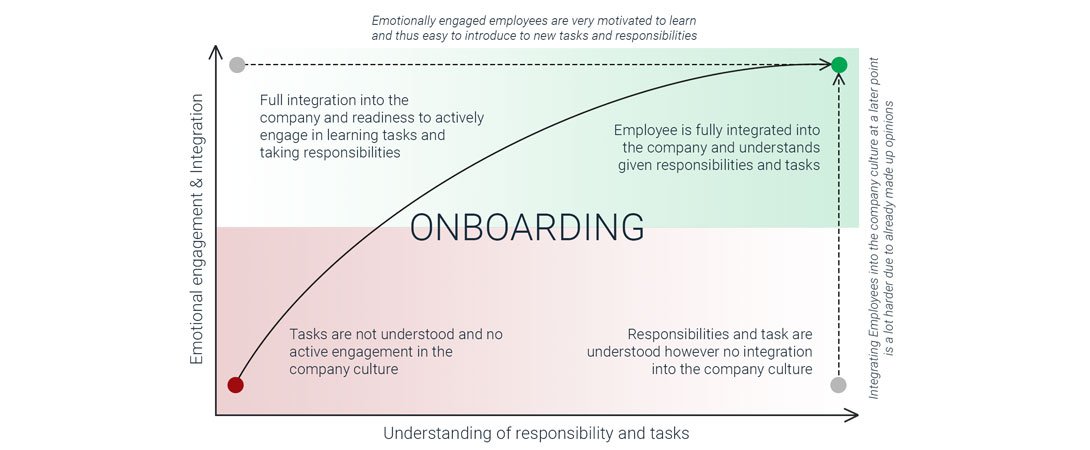Onboarding: The why and how.
09.06.2020 | Terence Hielscher

Everybody who ever had to spend some time on hiring a new employee knows that recruiting is not only a timely but also a very costly process. Employees are the heart of every company they are the main ones responsible for its success. It is, therefore, all the more important to not only retain existing employees but to onboard new hires effectively to integrate them into the company.
Now, what exactly is onboarding?
Onboarding is the initial process of assimilating new hires into an organization.
From introducing them to the team to telling them where the fire extinguishers are – everything they need to know, have to learn and experience during their first weeks is part of their onboarding process.
Why is an onboarding process important?
As we all know, hiring employees requires time, money and commitment. It is therefore in the best interest of each and every company to retain good employees – which is often very much dependent on how well they are onboarded. Employees who participate in a structured onboarding program are 69% more likely to stay with an organization for 3 years. An effective onboarding is supposed to integrate an employee not only in regards to their future tasks and responsibilities but also in regards to their assimilation into their team and the overall company culture. Both stages are equally important to guarantee that new hires are given everything they need to succeed.

Whose job is the onboarding of new employees
Since onboarding is considered the initial process of assimilating new hires into an organization, it makes only sense that the whole organization is part of the process. Dependent on the concerned position, some are required to be more present than others, however, overall, every person in a company is responsible to ensure that new colleagues feel comfortable. Assimilating a new employee into the organization does of course not happen overnight. There are different stages an employee has to go through and various points of contact who all have to work together.
The prep work
Now, before we go into the best practices of an efficient onboarding process, every company has to do some prep work to make sure that everything is included in the final checklist. To ensure that new employees are well prepared for their future position, there are four main areas of interest that should be covered – The 4 C’s:
-
Clarification
Clarifying the scopes of the open position already starts when an position is being communicated. The job description should include a rough outline that should be discussed further during the interview phase. Once new employees start to actually work, it is time to go into much more detail. What exactly are the tasks and responsibilities and what are the expected outcomes – This is obviously a very much ongoing process, as new tasks will keep coming in constantly. - Compliance
New employees have to be introduced to information regarding legal issues, rules and regulations as well as basic information such as safety instructions. This includes simple issues like the location of fire extinguishers as well as more complex affairs like confidentiality agreements. - Culture
The culture of a company has become a make or break factor for many jobseekers over the past years. Especially Milienials and Gen Zs are not only having a closer look at the position itself, but rather the overall work enviroment. Introducing new employees to organizational norms is essential to guarantee that they feel welcome and are enjoying their everyday worklife.
.

- Connection
Last but definatelly not least, it is important to help new employees establish networks and relationships. To goes for both, internal connections within their team and crossdepartmental troughout the company, as well as externally including customers and partners.
Best practice
Now, there are already many tips and tricks on how to onbard new employees, but out of all of them there is one that is essential: Ask new hires how they like to be managed. People do not only have their distinct style in leadership, they also have a distinct style in how they like to be led. As always in life – communication is the key to success.
To ensure an efficient and most importantly consistent onboarding process every company should have its individual checklist in place. As onboardings are a cross-departmental process, it is important to have a manual in place that can be executed by all concerned employees. This list obviously different in each and every company as this is a very individual process, however, we have prepared a small guide with activities and responsible parties to help you get started.
Prior to start date:
- Confirm start date and time [Superior]
-
Create welcome package and set up work station [Office management / IT]
First day(s):
-
Welcome and introduction to main peers [Superior]
-
Review software, hardware, printers, email setup etc. [IT]
-
Go trough break / meal policies [Office management]
-
Introduction to tools e.g. for communication [Superior]
-
Go through compliance and legal issues [HR, Superior, Office management]
-
Provide a company contact list [Office management]
-
Go for luch / after work drinks [Peers]
First week(s):
-
Discuss responsibilities and objectives [Superior]
-
Review organizational structure and meet the extended core team [Superior, Office management]
-
Discuss strengths and development needs and desires [Superior]
-
Regular 1:1 meetings [Superior]
After 3 months:
-
Assess progress and make responsibility adjustments [Superior]
-
Introduction to more complex projects [Superior]
-
Further introductions [Superior, Peers]
After 6 months / End of first year
-
Performance review [Superior]
-
Review short- and longterm goals [Superior]


